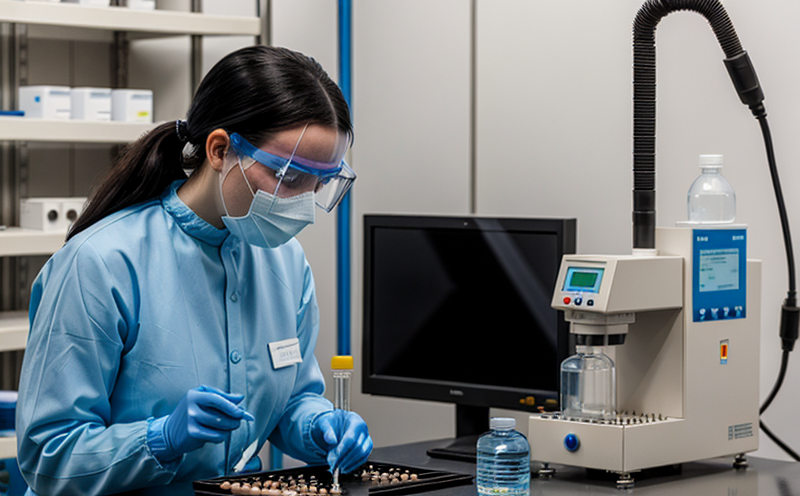HPLC Related Substances Testing
High Performance Liquid Chromatography (HPLC) is a sophisticated analytical technique used in pharmaceutical testing to assess the purity and composition of drug substances. This service focuses on identifying and quantifying impurities, related substances, and degradants present within a sample. The HPLC method separates these components based on their interactions with a stationary phase, allowing for precise identification and measurement.
The process begins with the preparation of the sample, which involves dissolving it in an appropriate solvent followed by filtration to ensure clarity. Chromatographic columns used vary depending on the nature of the substance being analyzed. For instance, reversed-phase columns are commonly employed for polar compounds while normal-phase columns suit non-polar substances.
Once prepared, the sample is injected into the HPLC system where it travels through a series of detectors designed to capture data at specific wavelengths or across broad spectral ranges. These detectors provide quantitative and qualitative information about the components present in the mixture. The elution profile obtained from this process serves as critical evidence towards evaluating product quality.
In the context of pharmaceutical manufacturing, ensuring that drugs meet stringent purity standards is paramount for patient safety. By employing advanced HPLC techniques, laboratories can reliably detect even trace amounts of impurities or related substances which might otherwise go unnoticed by less sensitive methods.
It's important to note that HPLC-related substance testing adheres strictly to international guidelines such as ICH Q3A and EU guidelines for drug substances. Compliance with these standards ensures consistent results across different batches manufactured under varying conditions, thereby enhancing confidence in the reliability of analytical data generated during development phases.
The significance of this service extends beyond mere compliance; it plays a crucial role in product development by providing valuable insights into potential issues early on. Early detection allows for corrective actions to be implemented before they become problematic later stages of production or post-market surveillance.
| Sample Type | Expected Detection Limit | Column Type | Detection Method |
|---|---|---|---|
| Powders & Crystals | < 0.1% w/w | Reversed-Phase | Infrared Detection (IR) |
| Liquids | < 0.05% w/v | Normal-Phase | Photodiode Array (PDA) |
| Solvents | < 0.02% v/v | Cytosil C18 | NanoUV Detection |
The precision of HPLC makes it an indispensable tool for ensuring drug safety and efficacy throughout the entire lifecycle—from research to commercialization. Its ability to detect minute quantities of unwanted compounds ensures that only high-quality products reach patients.
In summary, HPLC related substances testing is a vital component in maintaining rigorous quality control standards within pharmaceutical manufacturing processes. It enables early identification of impurities or related substances, facilitating timely interventions and contributing significantly towards enhancing overall product safety and effectiveness.
Benefits
The benefits of HPLC related substances testing extend far beyond mere compliance requirements. By providing detailed insights into the purity profile of drug substances, this service helps ensure product quality and safety. Early detection allows for prompt corrective measures to be implemented, thereby minimizing risks associated with substandard products.
Moreover, this approach fosters continuous improvement by identifying potential areas for enhancement during development stages. It also enhances trust between stakeholders involved in various aspects of drug manufacturing, from suppliers to regulatory bodies.
In essence, incorporating HPLC related substances testing into your quality assurance strategy not only meets regulatory expectations but also contributes positively towards maintaining high standards of pharmaceutical excellence.
Industry Applications
- Detection and quantification of impurities in active pharmaceutical ingredients (APIs).
- Identification of degradation products during storage or processing conditions.
- Evaluation of stability over time through accelerated aging studies.
- Monitoring quality throughout manufacturing processes ensuring consistent batch-to-batch performance.
These applications underscore the importance of HPLC related substances testing in safeguarding public health and upholding professional integrity within the pharmaceutical sector.
Customer Impact and Satisfaction
- Enhanced confidence in product quality due to rigorous analytical methods employed.
- Faster resolution times for any identified issues leading to improved customer satisfaction.
- Cost savings achieved through early detection preventing costly rework downstream.
- Better informed decisions made possible by comprehensive data generated during analysis.
By leveraging HPLC related substances testing, customers benefit from enhanced reliability and accuracy in their products, ultimately contributing to improved patient outcomes.





